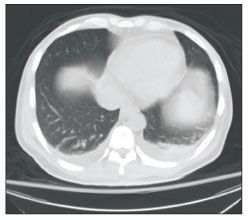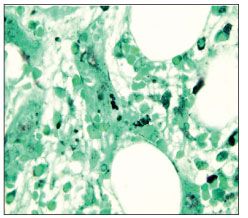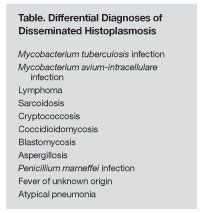- Clinical Technology
- Adult Immunization
- Hepatology
- Pediatric Immunization
- Screening
- Psychiatry
- Allergy
- Women's Health
- Cardiology
- Pediatrics
- Dermatology
- Endocrinology
- Pain Management
- Gastroenterology
- Infectious Disease
- Obesity Medicine
- Rheumatology
- Nephrology
- Neurology
- Pulmonology
An HIV-Infected Patient With Fever, Pancytopenia, and Renal Failure: Is This End-Stage AIDS?
Histoplasmosis is a fungal infection caused by Histoplasma capsulatum. Although immunocompetent persons with H capsulatum infections are usually asymptomatic, several clinical syndromes can manifest in immunocompromised patients.
Histoplasmosis is a widely prevalent fungal infection that is caused by the dimorphic fungus Histoplasma capsulatum, which is endemic to the Ohio, Missouri, and Mississippi river valleys. Histoplasmosis was categorized as an AIDS-defining illness in 1997. Most H capsulatum infections are asymptomatic; however, disseminated infection can occur in immunosuppressed patients (eg, AIDS patients receiving tumor necrosis factor a).1 Reports have suggested that approximately 5% of patients with AIDS who live in areas where H capsulatum is endemic have disseminated histoplasmosis.2
CASE REPORT
A 61-year-old man with AIDS whose CD4+ T-cell count was less than 10/µL and HIV RNA level was greater than 100,000 copies/mL presented to a Veterans Affairs medical center with a 4-month history of progressive clinical deterioration. He reported a 35-lb weight loss over the past 12 months. In addition, the patient noted a 2-week history of appetite loss, nausea, vomiting, and weakness.
Past medical history was significant for type 2 diabetes mellitus, peripheral neuropathy, hypogonadism, and hyperlipidemia. An HIV resistance study showed reduced susceptibility to all NRTIs, NNRTIs, and protease inhibitors. Serial chemistry studies revealed acute and chronic renal insufficiency, possibly attributable to HIV-related nephropathy in association with diabetes.
Several months before hospitalization, the patient had participated in a clinical trial of the protease inhibitor tipranavir, but he withdrew because of adverse effects. More recently, the patient had been receiving lamivudine, abacavir, and tenofovir. He also was taking trimethoprim/sulfamethoxazole (TMP/SMX) as prophylaxis for Pneumocystis jiroveci infection. TMP/SMX and antiretroviral agents (tenofovir in particular) were discontinued at admission because they were deemed to contribute to pancytopenia and potential renal toxicity.
The patient denied use of alcohol, tobacco, and drugs. In addition to antiretroviral agents and TMP/SMX, oral medications included pancrelipase, azithromycin, and omeprazole. Review of systems was significant for severe fatigue and diffuse lymphadenopathy. The patient denied oral lesions, headache, dyspnea, chest pain, cough, abdominal pain, and hematuria.
On admission, the patient appeared lethargic. His temperature was 35.3°C (95.6°F), blood pressure was 137/67 mm Hg, pulse rate was 107 beats per minute, and respiration rate was 20 breaths per minute. The patient was oriented to person and place but not to time. He had palpable bilateral cervical lymphadenopathy. Findings from the cardiac, pulmonary, and abdominal examinations were unremarkable. The neurological examination revealed generalized weakness in all extremities but no associated neuropathy.
Laboratory tests revealed pancytopenia, with a white blood cell count of 0.8 × 103/µL, a hemoglobin value of 13 g/dL, and a platelet count of 65 × 103/µL. The concentration of serum sodium was 126 mEq/L; potassium, 5.6 mEq/L; urea nitrogen, 104 mg/dL; and creatinine, 9.3 mg/dL. Serum alkaline phosphatase, total bilirubin, and transaminase concentrations were normal. The patient’s hematological and renal parameters had significantly changed compared with laboratory data collected 1 month before admission. Routine blood cultures were negative. Findings on the patient’s chest radiographs on admission were unremarkable.
Because of the patient’s advanced HIV disease status and modest T-cell count, typical opportunistic infections (OIs) were initially suspected. Given that the patient demonstrated fatigue and low-grade fever, early P jiroveci pneumonia was considered. The chronic constitutional symptoms also suggested the possibility of infection with either Mycobacterium tuberculosis or nontuberculous mycobacteria.
Bartonellosis and disseminated cytomegalovirus infection also were added to the differential diagnosis of chronic fever of unknown origin. Lastly, non-Hodgkin lymphoma was considered, given the patient’s presentation with malaise and generalized lymphadenopathy.
Recommendations were to restart antiretroviral therapy, begin dapsone for P jiroveci pneumonia prophylaxis, obtain a CT scan of the thorax (because some OIs can present with normal chest radiographic findings) and of the abdomen and pelvis to evaluate for hepatosplenomegaly and adenopathy not revealed by physical examination. Cervical lymph node and bone marrow biopsies also were ordered.
In addition, the nephrology service was consulted to assist with management of renal insufficiency. Because the patient was lethargic and hypothermic on admission-and given his immunocompromised state-he was considered to be at high risk for occult sepsis and therefore treatment with intravenous vancomycin, piperacillin/tazobactam, and levofloxacin was started.

Figure 1. A thoracic CT scan showing bilateral small pleural effusions with some associated patchy infiltrate and atelectasis.
A CT scan of the chest showed small pleural effusions with some patchy infiltrate and atelectasis (Figure 1). CT scans of the abdomen and pelvis revealed moderate mediastinal and hilar lymphadenopathy as well as mild abdominal and pelvic lymphadenopathy. Lymph node biopsy was deferred at that time because of thrombocytopenia.
On hospital day 7, the patient remained pancytopenic and had become febrile 2 to 3 days into his hospital stay. At that time, antibiotics were discontinued to rule out drug fever, but the patient was given empirical therapy with rifabutin, ethambutol, and azithromycin for Mycobacterium avium-intracellulare infection. However, because blood cultures remained negative for acid-fast bacilli, bone marrow aspiration was performed. Examination of the bone marrow aspirate revealed small intracellular yeast forms, consistent with disseminated H capsulatum infection (Figure 2).
DISCUSSION
The diagnosis of disseminated histoplasmosis in our patient was made by bone marrow biopsy. Bronchoalveolar lavage was not pursued to validate the diagnosis of disseminated histoplasmosis, and it should be noted that in up to 50% of patients with disseminated histoplasmosis, findings on chest radiographs are normal. Abnormal findings on chest radiographs may include multiple small, diffuse, nodular opacities.3

Figure 2.Gomori methenamine silver stain of a core bone marrow biopsy section showing small (2 to 4 µm in diameter) darkly stained budding yeasts clustered at the center of the specimen and scattered throughout the marrow space, compatible with a diagnosis of disseminated histoplasmosis. (Photo courtesy of Steven Agosti, MD, department of pathology, Tampa VA Medical Center, Florida.)
The differential diagnoses of disseminated histoplasmosis, which can include infectious diseases, malignant tumors, and inflammatory syndromes, are listed in the Table. Diagnosis of histoplasmosis can be made by the recovery of H capsulatum in cultures of sputum, bronchoalveolar lavage specimens, or bone marrow; by the identification of compatible organisms in the pathological specimen; or by testing for H capsulatum polysaccharide antigen in a urine specimen.
The mortality rate in patients in whom disseminated histoplasmosis is untreated is 80%. Antifungal therapy reduces the mortality rate to less than 25%.4 Thus, all patients with progressive disseminated histoplasmosis should receive treatment. The success of treatment also depends on the severity of disease, as demonstrated by several trials.5-8
Current guidelines recommend that a 12-week course of amphotericin B deoxycholate (AmBD) be given as induction therapy.9 If the patient is unable to tolerate AmBD, which is considered the drug of choice, other options include itraconazole (200 mg bid) and fluconazole (800 mg/d). There is a lack of data regarding the use of newer lipid formulations of amphotericin B in the treatment of disseminated histoplasmosis,9 but the reduced toxicity seen with these agents may make them a reasonable option.

Therapy is not curative for histoplasmosis in patients who have HIV/AIDS. Lifelong maintenance therapy is recommended to prevent relapse. The preferred agent for maintenance therapy is itraconazole, 200 mg once or twice daily for life. Close monitoring for drug interactions is essential for patients who are also taking antiretroviral agents (protease inhibitors in particular). Fluconazole is not recommended for long-term maintenance therapy because its effectiveness is reduced over time and because drug resistance may emerge.9
Our patient was given a regimen of 3 mg/kg/d of amphotericin B lipid complex (ABLC). Within 48 hours, he began to defervesce. His clinical status and renal function improved relatively quickly following 2 dialysis sessions and institution of a potent antiretroviral salvage regimen (tenofovir, abacavir, lamivudine, tipranavir, ritonavir, enfuvirtide), antifungal therapy, and supportive care. His renal insufficiency was thought to be caused by a combination of HIV-associated nephropathy, acute tubular necrosis, and microbial infection.
The patient completed 14 days of therapy with ABLC; the medication was then switched to oral itraconazole. He continued to do well 6 weeks after treatment was instituted.
Because the patient was thought to have end-stage AIDS, the possibility of a systemic fungal disorder was not initially entertained. After the diagnosis of histoplasmosis was made and the patient was given appropriate antifungal and salvage antiretroviral therapy, his clinical response was significant.
The case exemplifies the importance of actively pursuing the diagnosis of an OI in patients with end-stage HIV disease. OIs in patients with end-stage disease should be treated aggressively, and antiretroviral effectiveness should be maximized. This strategy may prolong the life and quality of life of patients with AIDS.
References:
References
1.
Vathesatogkit P, Goldenberg R, Parsey M. A 27-year-old HIV-infected woman with severe sepsis and pulmonary infiltrates. Disseminated histoplasmosis with severe sepsis and acute respiratory failure.
Chest
. 2003;123:272-276.
2.
Hajjeh RA, Pappas PG, Henderson H. Multicenter case-control study of risk factors for histoplasmosis in human immunodeficiency virus-infected persons.
Clin Infect Dis
. 2001;32:1215-1220.
3.
Truong MT, Sabloff BS, Munden RF, Erasmus JJ. A patient with new-onset seizure and mediastinal adenopathy.
Chest
. 2004;126:982-985.
4.
Shelburne SA 3rd, Visnegarwala F, Adams C, et al. Unusual manifestations of disseminated histoplasmosis in patients responding to antiretroviral therapy.
Am J Med
. 2005;118:1038-1041.
5.
Sathapatayavongs B, Batteiger BE, Wheat J, et al. Clinical and laboratory features of disseminated histoplasmosis during two large urban outbreaks.
Medicine (Baltimore).
1983;62:263-270.
6.
Wheat J. Histoplasmosis in the acquired immunodeficiency syndrome.
Curr Top Med Mycol
. 1996;7:7-18.
7.
Wheat J, Hafner R, Korzun AH, et al. Itraconazole treatment of disseminated histoplasmosis in patients with the acquired immunodeficiency syndrome. AIDS Clinical Trial Group.
Am J Med
. 1995;98:336-342.
8.
Wheat J, MaWhinney S, Hafner R, et al. Treatment of histoplasmosis with fluconazole in patients with acquired immunodeficiency syndrome. National Institute of Allergy and Infectious Diseases Acquired Immunodeficiency Syndrome Clinical Trials Group and Mycoses Study Group.
Am J Med.
1997;103:223-232.
9.
Wheat J, Sarosi G, McKinsey D, et al. Practice guidelines for the management of patients with histoplasmosis. Infectious Diseases Society of America.
Clin Infect Dis
. 2000;30:688-695.
